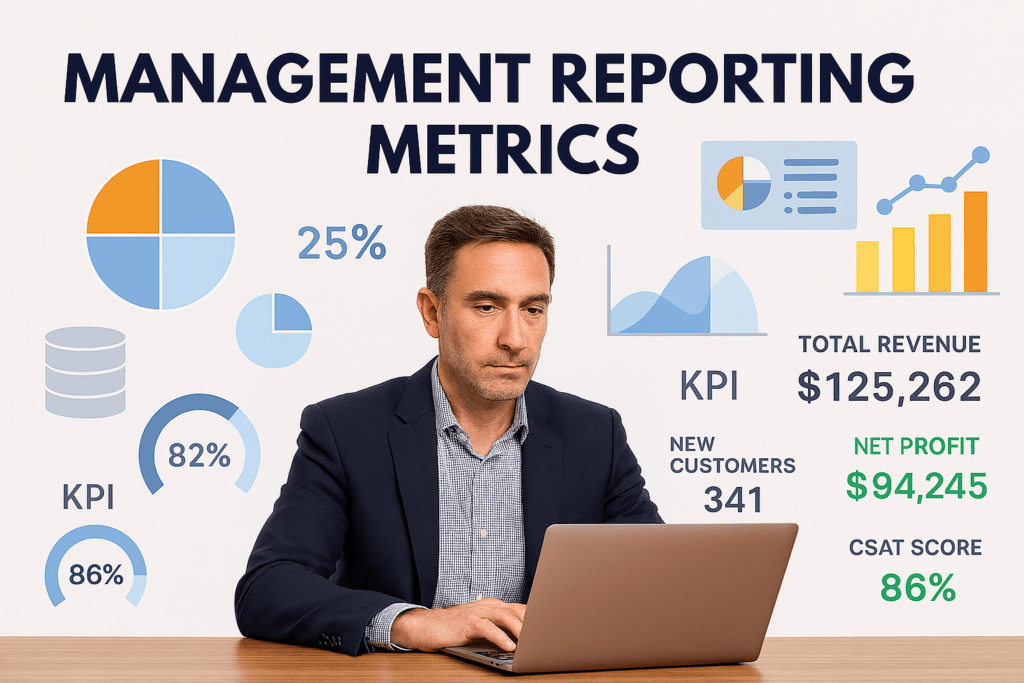Beyond the Spreadsheet: Why a Management Reporting System is Your Key to Proactive Leadership

In today’s fast-paced business environment, without true management reporting, running a company on gut feeling or outdated reports is like sailing a ship through a storm with a blurred map. Department Managers and C-level Executives are tasked with making critical decisions every day. But without a clear, accurate, and timely view of what’s happening across the organization, those decisions are based on guesswork, not knowledge.
This is where a modern Management Reporting System (MRS) transitions from a “nice-to-have” IT tool to an essential strategic asset. It’s the engine that transforms raw data into actionable intelligence, empowering leaders at every level to steer the company with confidence.
What is a Management Reporting System?
At its core, an MRS is a centralized platform that automatically gathers data from across your organization—from sales and marketing to finance, operations, and HR. It consolidates this information into intuitive dashboards and reports, providing a single source of truth. Think of it as moving from a pile of disjointed spreadsheets to a dynamic, interactive command center.
The Essential Value for Department Managers and C-Level Executives
The power of an MRS lies in its ability to serve both the high-level strategic needs of the C-suite and the detailed, operational focus of department managers.
For the C-Level Executive: The 30,000-Foot View with Drill-Down Capability
C-level executives need to answer big-picture questions: Are we profitable? Are we growing? What are our key risks and opportunities? An MRS provides:
-
A Unified, Real-Time Overview: The CEO and CFO can log in each morning to a dashboard showing Key Performance Indicators (KPIs) like company-wide revenue, cash flow, customer acquisition costs, and overall profitability. This holistic view eliminates surprises and aligns the leadership team.
-
Strategic Alignment: Easily track progress against strategic goals. If the objective is to increase market share in a specific region, the MRS can show relevant metrics, allowing executives to see if the strategy is working without waiting for end-of-quarter manual reports.
-
Informed Strategic Shifts: When you spot a trend—like a dip in profitability—you don’t have to wonder why. With drill-down capabilities, you can click on that metric to see which product line, region, or department is driving the change. This turns a high-level alert into a targeted investigation.
For the Department Manager: The On-the-Ground Operational Intelligence
Department managers are in the trenches, and their success depends on granular, timely data. An MRS equips them to:
-
Optimize Daily Operations: A Sales Manager can monitor the team’s pipeline, conversion rates, and average deal size in real-time. An Operations Manager can track inventory levels, production efficiency, and quality control metrics. This allows for immediate adjustments to improve performance.
-
Empower Data-Driven Accountability: Managers can clearly see which initiatives are working and which are not. They can allocate resources more effectively, whether it’s shifting marketing spend to a high-performing channel or addressing a bottleneck in the service delivery process.
-
Foster Proactive Management: Instead of reacting to last month’s problems, managers can be proactive. For example, if the MRS shows a rising trend in customer support ticket resolution time, the Support Manager can investigate and allocate staff before it becomes a major customer satisfaction issue.
The Power of Proactive Knowledge: From Reactive to Predictive
The ultimate benefit of a robust Management Reporting System is the shift from a reactive to a proactive and predictive operational model.
-
Identify Trends, Not Just History: Static reports tell you what already happened. A dynamic MRS helps you see what is happening. By visualizing data over time, you can identify trends—both positive and negative—as they emerge.
-
Improve Forecasting Accuracy: With a clear historical and current view of performance, forecasting becomes more reliable. You can base future budgets and strategies on solid data trends rather than assumptions.
-
Enhance Cross-Departmental Collaboration: When sales, marketing, and finance all look at the same data, silos break down. A shared understanding of metrics leads to more productive conversations and aligned goals across the organization.
Conclusion: An Investment in Clarity and Control
A Management Reporting System is no longer a luxury reserved for large corporations. It is a fundamental tool for any organization that values clarity, agility, and data-driven decision-making. For C-level executives, it provides the strategic oversight needed to guide the company. For department managers, it delivers the operational insights required to excel in their roles.
By implementing a modern MRS, you empower your entire leadership team to move beyond simply reporting on the past and start actively shaping a more successful and predictable future.
We have implemented comprehensive management reporting systems for Mid, Large Organizations including Broadcast, Financials and more. Check out our Case Studies.
Ready to turn your data into your greatest strategic advantage?
Contact Us to learn more about our initiatives in this area.
Resources:
What Is a KPI Dashboard | Microsoft Power BI
Here’s how Microsoft executives are using Power BI | Blog di Microsoft Power BI | Microsoft Power BI










